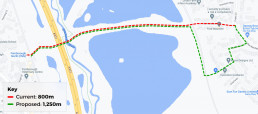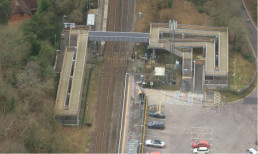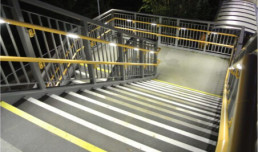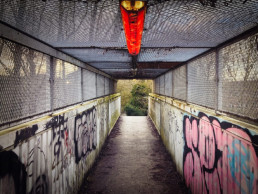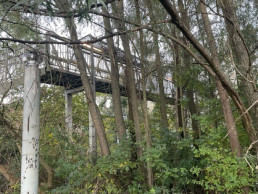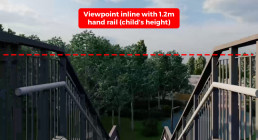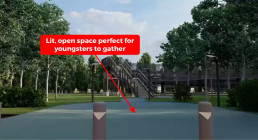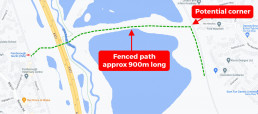Why a bridge?
Network Rail has a strict statutory duty to run a safe railway network and eliminate risks from it. They believe that level crossings are one of the key sources of catastrophic risk and they have a funded strategy to reduce it.
The Hatches is considered a high risk footpath level crossings and has significant and irremovable safety issues e.g. restricted sighting of trains which is currently mitigated by trains sounding their horns.
Network Rail have gone through a process to determine what they believe is the best solution i.e. an accessible bridge at Spencer Close.
Where will the bridge be located?
Network Rail are proposing putting the bridge at the end of Spencer Close. There would then be a pathway parallel to the train line joining the existing path near the existing Hatches crossing.
Network Rail chose Spencer Close as it offered the shortest distance back to the pathway plus the availability of land to construct the bridge.
What about other locations?
- Grenville Gardens and Gloucester Close provided very little space for bridge construction and have environmental issues such as bodies of water that would make it difficult to re-join the pathway.
- Chartwell does not offer the existing natural access point to the land to the west that Spencer Close does. At Chartwell there is a ransom strip in place which is not the case at Spencer Close. Also, the distance travelled by the user would be greater.
Concerns raised
In diverting the current bridlepath, the distance to get from the top of the Hatches to Farnborough North increases by approximately 0.5km. In short, it roughly doubles the walking time to the station and, proportionately, has an even bigger impact on leisure walkers, dog walkers and fishermen who may not go as far as the station. So there is a good case that it would be substantially less convenient.
At a time when councils are being encouraged to promote public transport, cycling and walking, the additional distance, time and inconvenience of ramps could drive users to alternative methods of transport.
The area to be significantly affected by the bridge has been surveyed over many years by a local British Trust for Ornithology bird ringer and members of The British Herpetological Society.
There are many records of Adders and Grass snakes on the site. Adders are a protected species under the Wildlife and Countryside Act (WLCA) 1981 and a priority species under the UK Post-2010 Biodiversity Framework.
Roe deer, muntjac, foxes and badgers are often seen here.
The birdlife is exceptional and over 40 passerine species are regularly monitored. Over 7,000 birds have been processed here by the Frimley Ringing Group. These include protected species under the WLCA such as Kingfisher, Firecrest and Brambling. The site is important for Greenfinch, a species that is declining nationally and subject to particular viruses and was used for a study on the national impact of viruses on the species. The site is also used for national Winter Constant Effort Site monitoring of species for the British Trust for Ornithology.
The proposed route of the footpath and bridge footprint will obliterate the hedgerow where the majority of the birds are found. This native planted hedgerow was itself created for wildlife restoration as a result of the digging of the gravel around 40 years ago.
At a time of climate emergency, Network Rail are looking to remove approximately 1,200m2 of trees for this project. These trees are not only a good habitat but they screen the houses from the noise of the railway and the pollution caused by the trains.
Any replacement trees will likely be mature saplings which will take 20 years to provide adequate screening.
Residents are concerned that users of the bridge and fisheries will start to park along Spencer Close, Bedford Crescent and Winston Close. Network Rail have been quick to dismiss such concerns, suggesting that fisherman will park in the fisheries car park going forward. In depth analysis of this matter must be undertaken to support this theory. The lives of those living in these quiet roads could be severely impacted.
Network Rail indicated that parking permits could be introduced along Spencer Close, but this itself comes with many negatives and only pushes the problem to neighbouring streets.
What will the bridge look like?
Bridge Type
It will be a stepped and ramped footbridge to provide access for all user types.
Material
The bridge will be fabricated of steel and painted in a colour of Network Rail’s choice.
Height
The highest point (the top of the railings on the highest deck) is 8.1 metres high, including the parapet height of 2.1 metres from the top deck level.
Lighting
Lighting will be provided throughout the night, being triggered by motion sensors to prevent light pollution during these hours.
Privacy
Measures such as tree walls surrounding the bridge on the residential side would be put in place. Privacy parapets would be installed on the bridge so that overlooking of neighbouring houses is prevented.
Security
The area around the bridge will be fenced off so there is no access into surrounding areas. Fences will also separate the new pathway back up to the existing pathway to prevent access into the fisheries and the railway.
Safety
The ramps would be built as per the Network Rail standard, with slope gradients to the DIA standard to ensure that slopes will be to the safest gradient (1:15) and flat areas regularly spaced to allow resting between climbs. Cyclists and mobility-constrained users would be encouraged to use the ramps, with cyclists being encouraged to dismount.
Built examples
There is a similar bridge at Gomshall station in Surrey on the North Downs Line – images shown below.
Concerns raised
The appearance of the bridge will be completely out of keeping with the location and, as it is positioned directly at the end of Spencer Close, will become an eye sore. There has been no attempt by Network Rail to take onboard feedback about moving the bridge further South (to the left), so it’s not in direct view or overlooking the street.
Residents are concerned the bridge’s appearance will further deteriorate from graffiti. This example of a Network Rail pedestrian bridge is a mere 2.5 miles away in Crabtree Park, Camberley. This demonstrates Network Rail are either incapable or not interested in maintaining these infrastructure projects once they are in place.
Another concerning example of Network Rail’s footbridge maintenance is this incident at Kennedy Road, Barking from August 2022. The floor of the footbridge collapsed and a user fell landing close to the line. Fortunately his injuries were not life-threatening. View ITV News article and video.
Residents are extremely concerned about the prospect of having a bridge which is over eight metres tall so close to their homes. The three homes at the end of Spencer Close will be most impacted by this and Network Rail’s promise of tree walls and privacy parapets do little to appease these concerns.
Network Rail have created a visualisation that actually shows residents would be even more overlooked than previously feared. The viewpoint from the top of the steps is unnaturally low and hasn’t considered the train tracks are a couple of meters higher, meaning the entire bridge will be higher. Rows of mature trees have been strategic positioned to block the view to resident’s gardens. It seems extremely unlikely that this would be the reality from day one, and if it is, I suspect the cost to plant and maintain these would be high.
One of the families who will be overlooked have even greater reason to be concerned. Their son is 18 and has severe ASD (Autism Spectrum Disorder) and ADHD. He has communication difficulties, and his levels of understanding are low for his age. These age ranges are 5-7.
The Autism means that the world can be a very frightening place for him. He sees home as his refuge where he can relax and be in his own little world. Any changes to his surroundings can cause him great distress which then causes the family distress. He loves his trampoline in the garden as it is so quiet there he can spend hours in the garden even just sitting on the trampoline. Their main concerns are if he feels he is being observed or hears people or different sounds he won’t go out in the garden. With his ADHD he uses his trampoline to release all his built pressure. If he can’t do this properly, he can get aggressive and very anxious.
If the building of the bridge goes ahead this will also cause them grief as he has sensitivity issues with noise so would need notice when work will be done so they can prepare him and make other arrangements.
Network Rail have indicated that lighting will be provided throughout the night, being triggered by motion sensors to prevent light pollution during these hours.
In the Narrative risk assessment (2.9.8) they state that the crossing has a high amount of usage during the night. On average 97 people use the bridge between midnight and 6am.
Residents are extremely concerned by the prospect of lights going on and off almost 100 times each night during these antisocial hours and the impact it could have on them.
On the visualisation it shows a large number of mature trees would need to be removed to cater for the bridge. These trees currently act as a buffer to reduce the noise of the passing trains. Removing them directly at the end of the road would increase noise levels along Spencer Close.
Local residents are concerned there will be an increase in crime and antisocial behaviour due to the bridge.
On the visualisation, the pathway leading up to the bridge is well lit and vast, so makes a great area for youngsters to gather at all hours. The ramps and steps will also no doubt provide an attraction for youngsters to climb, skateboard and cycle down. This then becomes an intimidating prospect for users, but also an ongoing nuisance to local residents.
There is also the concern that properties along Spencer Close and adjoining streets could be targeted by burglars and opportunists. The street has always been a quiet cul-de-sac, with no through traffic, so having 300 users passing through will change the dynamic significantly.
There was an incident as recently as May 2021 on the Hatches where there was criminal damage and theft – Facebook article.
When asked, Network Rail have not been receptive to installing security cameras and have provided no evidence to support their argument that there would be no negative impact.
Residents are concerned about increased littering on the route and particularly around the bridge. When questioned, Network Rail have given no indication that any bins would be installed, they have only indicated that the bridge parapets would prevent people from littering onto the line – although it would appear that this would still be possible from the ramps unless the intention is to add parapets to these too?
Regardless, the parapets obviously don’t prevent users from dropping litter anywhere else around the bridge and it appears that Network Rail don’t consider this an issue or their responsibility.
How much will the bridge cost?
Costs for the Hatches in October 2021 were around £3m, and so if inflation of approximately 20-25% is included then costs reach the £3.7M mark. Further additional scope for ramp changes and footpath design will affect the price.
Network Rail will need to purchase land from the fisheries to build the new path back to the existing Hatches path. It is not clear if this is included within this cost.
Concerns raised
The “working cost” of £3.7m has gone up significantly from the original £2.4m quoted.
The proposed site is complex with nearby waterways, lakes, trees and wildlife to relocate so it’s reasonable to predict that this figure will rise.
Network Rail also have a reliance on purchasing third-party land (from the fisheries) in order to build the new pathway linking back to the original one west side of the Hatches crossing. Network Rail have not confirmed if this is included in this working cost.
Many residents have been very vocal about what they consider to be a grotesque misuse of funds. It’s particularly unpalatable in the current economic climate and with Network Rail strikes ongoing, many believe the funds could be better spent elsewhere.
Many residents find it difficult to understand why Network Rail are so set on a bridge when the cost continues to rise and when there is an alternative option in Miniature Stop Lights.
Miniature Stop Lights would increase the safety by approximately 60% on the existing level crossing but at a much lower cost, bringing it down to a level well below many other crossings on the network. It would also remove the need for whistleboards (the horn). The addition of alternative technologies, such as radar controlled obstacle detection will be available soon to further enhance crossing safety, certainly within the lifespan of the bridge and could be installed to further improve safety.
Throughout Network Rail’s risk assessment, consultation and website there seems to be an unbalanced representation of the pros and cons of the two solutions and many residents believe Network Rail have done this draw attention away from this option as there is little difference in their Cost Benefit Analysis scores.
During the final consultation, when questioned, Network Rail representatives were unwilling to say if Miniature Stop Lights would be the “Plan B” if the spiralling cost of the bridge becomes unacceptable. One Network Rail representative even said “they don’t work” which contradicts the 60% safety improvement quoted and used for their own risk assessment.
It also doesn’t align to the news that Network Rail are actively installing 90+ Miniature Stop Lights across Anglia between 2021 and 2024. Why is this solution suitable for each of these crossings but not at the Hatches?
Alongside the cost benefits of Miniature Stop Lights, many of the other concerns raised by residents and users would be addressed.
How safe is a bridge?
Network Rail determine safety by the risk of being hit by a train. Based on this criteria, the chances of being hit are zero.
No records or information has been provided around deaths or injuries on bridges.
No information has been provided around maintenance of a bridge i.e. gritting, vandalism etc.
Concerns raised
In the Narrative Risk Assessment, the “All Level Crossing Risk Model” (ALCRM) score used in the Cost Benefit Analysis gives the bridge options a perfect safety score as it only considers incidents that occur on a crossing. Of course this is not a true reflection of bridge safety.
One of the main threat to life risks is suicide. It would appear that bridges are a greater risk than crossings and that alone throws Network Rails claim into doubt. They have refused to provide any data on this. They have also failed to provide any other evidence regarding the wider risks related to footbridges (probably because it does not exist). Nonetheless, the claim that a bridge is safer has not been substantiated in any way.
To put level crossing deaths and suicides into perspective, Of the fatalities on the railway in 2019/20 6 occurred on a level crossing, 17 involved people trespassing on the railway, 283 were suicides or suspected suicides.
Here are some examples:
Deaths falling from a rail footbridge bridge (suspected suicides and uncertain circumstances)
- Berwick Hills, 2021
- Colchester 2020
- Eaglecliffe, 2000
- York, 2000
- Sittingbourne, 2017
- Smethwick Galton, 2015
- Colchester 2021
- Slade Green 2010
- Glasgow
- Durrington 2006
Injury
As we enter the winter months, how frequently (and who) will be ensuring the bridge is gritted and safe to cross? With approximately 300 users a day it’s not a high footfall, so surfaces will likely remain unsafe for longer or freeze over. If someone were to slip and fall down the steps (non Spencer Close side) there is the very real risk that they may not be heard or helped for some time.
When asked, Network Rail have not been receptive to installing security cameras, so it would rely on users or residents should any incident occur.
Network Rail’s Narrative Risk Assessment (2.8.5) identified 1,078 cyclists use the existing crossing over a 9 day period. It also says that many cyclists do not dismount (2.4.4 / 2.8.9). It seems highly probably that these same cyclists who struggle through the gate without dismounting will do the same on a bridge, in doing so create a risk to themselves and any other users they may encounter on the bridge.
As we enter the winter months, how frequently and who will be ensuring the bridge is gritted and safe to cross? With approximately 300 users a day it’s not a high footfall, so surfaces will likely remain unsafe for longer or freeze over. If someone were to slip and fall down the steps (non Spencer Close side) there is the very real risk that they may not be heard or helped for some time.
When asked, Network Rail have not been receptive to installing security cameras, so it would rely on users or residents should any incident occur.
There have been some concerns raised around how safe people will feel using the longer path.
The current path is straight giving good visibility of oncoming walkers and cyclists and has fences along both sides. At night there is lighting along it. The new path going from Spencer Close to join the existing Hatches path would appear to create a bend (based the visuals provided in the consultations). This bend would likely reduce visibility of any oncoming walker or cyclist.
The full length of the fenced off pathway between Farnborough North and Spencer Close would be approximately 900m with no exit along it, so if there was to be an accident / incident it would take help significantly longer to arrive.
Network Rail’s Narrative Risk Assessment (2.8.5) identifies a large number of lone female users (416 over 9 days) and so this needs to be a consideration. If users do not feel safe using the pathway and bridge (particularly at night), they will look for alternatives.
When asked, Network Rail have not been receptive to installing security cameras, so it would rely on users or residents should any incident occur.
Ecological impact
What ecological studies have been produced?
An ecological scoping assessment was produced in September 2020. The site could not be accessed so the report is of limited use.
A preliminary ecological appraisal was produced in August 2021. The surveyed area was found to be of low ecological value due to the lack of presence of notable / vulnerable / protected species within the work boundaries. Additionally, this is due to the localised nature of the vegetation clearance works, and significant presence of suitable habitat for a variety of valuable species with the locale.
What wildlife will be affected?
The area has been surveyed over many years by a local British Trust for Ornithology bird ringer and members of The British Herpetological Society.
There are many records of Adders and Grass snakes on the site. Adders are a protected species under the Wildlife and Countryside Act (WLCA) 1981 and a priority species under the UK Post-2010 Biodiversity Framework.
Roe deer, muntjac, foxes, bats and badgers are often seen here.
The birdlife is exceptional and over 40 passerine species are regularly monitored. Over 7,000 birds have been processed here by the Frimley Ringing Group. These include protected species under the WLCA such as Kingfisher, Firecrest and Brambling. The site is important for Greenfinch, a species that is declining nationally and subject to particular viruses and was used for a study on the national impact of viruses on the species. The site is also used for national Winter Constant Effort Site monitoring of species for the British Trust for Ornithology.
How many trees will need to be removed?
For the Hatches footbridge, 763m2 would need to be cleared, roughly 16 trees at 50 m2 per tree. The access path along the NR boundary would need 420m2, about 9 trees cleared / cut back. Both these options would consider how to limit this to as few as possible.
Concerns raised
Network Rail accepted that the preliminary ecological appraisal is not comprehensive and it was pointed out that disruption would affect everything from birds to adders (and bats, which were not mentioned but are seen in that vicinity regularly). This issue certainly needs more work and more transparency.
At a time of climate emergency, Network Rail are looking to remove approximately 1,200m2 of trees for this project. These trees are not only a good habitat but they screen the houses from the noise of the railway and the pollution caused by the trains.
Any replacement trees will likely be mature saplings which will take 20 years to provide adequate screening.
The area to be significantly affected by the bridge has been surveyed over many years by a local British Trust for Ornithology bird ringer and members of The British Herpetological Society.
There are many records of Adders and Grass snakes on the site. Adders are a protected species under the Wildlife and Countryside Act (WLCA) 1981 and a priority species under the UK Post-2010 Biodiversity Framework.
Roe deer, muntjac, foxes and badgers are often seen here.
The birdlife is exceptional and over 40 passerine species are regularly monitored. Over 7,000 birds have been processed here by the Frimley Ringing Group. These include protected species under the WLCA such as Kingfisher, Firecrest and Brambling. The site is important for Greenfinch, a species that is declining nationally and subject to particular viruses and was used for a study on the national impact of viruses on the species. The site is also used for national Winter Constant Effort Site monitoring of species for the British Trust for Ornithology.
The proposed route of the footpath and bridge footprint will obliterate the hedgerow where the majority of the birds are found. This native planted hedgerow was itself created for wildlife restoration as a result of the digging of the gravel around 40 years ago.
Construction
How long will it take to build the bridge?
The Spencer Close bridge construction team would be on-site for approximately 40 weeks. The production team is working on lessening these timescales.
Much of the bridge construction work would need to be done during the night when trains are not running.
Do you oppose Network Rail's bridge proposal?
If you don’t agree with what Network Rail are proposing, there are things you can do.
Doing nothing will be seen as a positive response by Network Rail.

